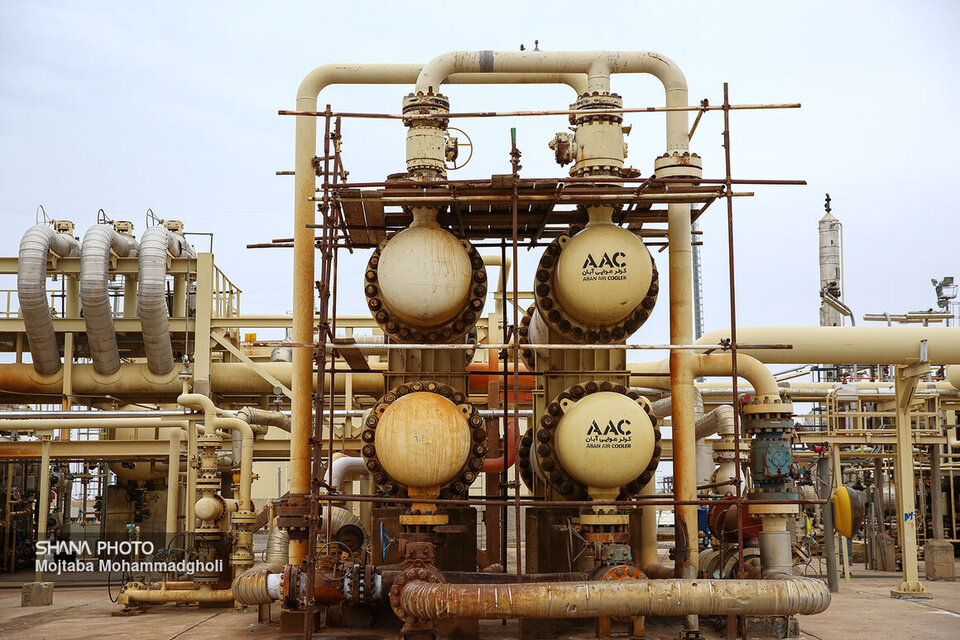Iran holds over 33 trillion cubic meters of natural gas reserves, accounting for approximately 17% of the world's proven natural gas reserves. With an annual production of 275 billion cubic meters, Iran ranks as the world's third-largest gas producer.
Before the Islamic Revolution, the focus was primarily on oil extraction, and natural gas was considered a byproduct. As a result, many gas fields were flared due to a lack of infrastructure, and the domestic gas network was limited, with much of the country relying on liquid fuels.
Following the revolution, the development of the South Pars gas field—the world's largest, supplying over 70% of Iran's gas consumption—alongside the expansion of gas processing facilities in Ilam, Fajr Jam, and Hasheminejad, significantly boosted gas production.
Iran's current daily gas production capacity exceeds 1 billion cubic meters, with nearly 600 million cubic meters processed daily at 13 South Pars gas refineries and injected into the national grid. Over 70% of the country's energy mix is now supplied by natural gas. Over the past 46 years, Iran's gas industry has grown exponentially, positioning the country as a key player in the global energy market.
Here is some key components of Iran’s gas industry:
20 gas refineries
Iran operates 20 active gas refineries, primarily located in South Pars (13 refineries) and other regions. These facilities are crucial for refining and processing natural gas for domestic consumption and export.
Refining capacity at over 1 bcm
Extracted natural gas typically contains impurities such as water, sulfur compounds, carbon dioxide, and heavy hydrocarbons. Refining and dehydration are essential for its transmission and use.
Iran's refining and dehydration capacity has reached 1,087 million cubic meters per day, thanks to the expansion of facilities like South Pars, Fajr Jam, and Ilam.
Over 40,000 km of pipeline
Iran's gas pipeline network has expanded significantly over the past 46 years, growing from 2,900 kilometers in 1979 to 40,223 kilometers by December 2024. These pipelines serve as the main arteries for transporting natural gas from production sites to consumption centers across the country.
94 gas pressure boosting stations
Pressure boosting stations are vital for maintaining gas pressure in transmission lines. Their number has increased from 8 in 1979 to 94 by December 2024, with one station commissioned during the 14th administration.
Over 461,000 km of gas distribution network
Iran's urban and rural gas distribution network is one of the most extensive in the world, growing from 2,050 kilometers in 1979 to 461,907 kilometers by December 2024.
This expansion has brought natural gas to millions of households and industries.
32m gas-supplied units
In addition to households, industries are major consumers of natural gas, with power plants playing a key role in electricity generation.
Public facilities such as schools, hospitals, mosques, and government offices are also connected to the gas network. The number of gas-supplied units has risen from 51,000 in 1979 to 32 million by December 2024.
29m urban, rural subscribers
The use of natural gas in cities and villages has significantly reduced fossil fuel consumption, lowered household costs, and contributed to environmental protection and social equity.
The number of subscribers has grown from 47 in 1979 to 28.8 million by December 2024.
Gas supply to 1,264 cities
Gas supply to cities has been a major development project since the 1980s. The number of gas-supplied cities has increased from 9 in 1979 to 1,264 by December 2024, with 99% of the country's cities now connected to the natural gas network.
Gas Supply to over 40,000 villages
Rural gas supply has been a priority in recent decades, aimed at providing clean energy, reducing liquid fuel consumption, and improving public welfare. The number of gas-supplied villages has risen from 2 in 1979 to 40,756 by December 2024, with 88% of villages now connected.
Daily gas production increase of 33 mcm
Efforts to maximize and stabilize gas production have led to a daily increase of 33 million cubic meters in raw gas production during the first five months of the 14th government.
Over 92 bcm of gas consumed in residential sector
Residential gas supply is a priority, especially during cold seasons. From the beginning of 2024 to December, 92.2 billion cubic meters of gas were allocated to residential, commercial, and non-major industrial sectors.
Over 68 bcm of gas allocated to power plants last year
Power plants, as the main electricity producers, rely heavily on natural gas. Gas consumption in power plants has increased from 1.5 billion cubic meters annually in 1979 to 68.4 billion cubic meters in the year to March 19, 2024.
46 bcm of gas consumed by major industries
Major industries, including petrochemicals, refineries, steel, and cement, are significant gas consumers. Gas consumption in these industries reached 45.8 billion cubic meters During March 20-December 19, 2024.
16.6 bcm of gas exported last year
Iran has expanded its gas exports, reaching 16.6 billion cubic meters in 2023, with 7.1 billion cubic meters exported during the first five months of the 14th government.
800 mcm of energy savings certificates issued
The Ministry of Oil issued 800 million cubic meters of energy savings certificates in the month ending December 19, 2024 to support optimization projects, including renewable power plants, metro systems, and CNG vehicle conversions.
Development of natural gas storage capacity
Gas storage projects are underway to balance production and consumption, enhance supply stability, and meet peak demand.
Six storage projects are currently in development or exploration phases, with plans to store 120 million cubic meters of gas during peak consumption periods.
Iran's gas industry has undergone remarkable growth over the past 46 years, transforming the country into a global energy powerhouse and significantly improving the quality of life for its citizens.


Your Comment